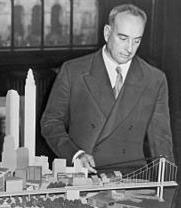Robert Moses
Robert Moses (1888-1981) was the "master builder" of mid-20th century New York City, Long Island, Rockland County, and Westchester County, New York. From the 1930s to the 1960s, Robert Moses was responsible for the construction of the Throgs Neck, the Bronx-Whitestone, the Henry Hudson, and the Verrazano Narrows bridges. His other projects included the Brooklyn-Queens Expressway, the Staten Island Expressway, the Cross-Bronx Expressway, the Belt Parkway, the Laurelton Parkway, and many more. He was the mover behind Shea Stadium and Lincoln Center, and contributed to the United Nations headquarters. Before Mr. Moses, New York State had a modest amount of parkland; when he left his position as chief of the state park system, the state had 2,567,256 acres. He built 658 playgrounds in New York City, 416 miles of parkways and 13 bridges. Moses's projects were considered by many to be necessary for the region's development after being hit hard by the Great Depression. During the height of his powers, New York City participated in the construction of two huge World's Fairs: one in 1939 and the other in 1964. His decisions favoring highways over public transit helped create the modern suburbs of Long Island and influenced a generation of engineers, architects, and urban planners who spread his philosophies across the nation. ''Those who can, build,'' Mr. Moses once said. ''Those who can't, criticize.''
His works remain extremely controversial. His supporters believe he made the city viable for the 21st century by building an infrastructure that most people wanted and that has endured. His critics point out that he displaced hundreds of thousands of residents in New York City, destroying traditional neighborhoods by building expressways through them, and claim that he preferred automobiles to people, contributed to the ruin of the South Bronx and the amusement parks of Coney Island, caused the departure of the Brooklyn Dodgers and the New York Giants Major League baseball teams, and precipitated the decline of public transport through disinvestment and neglect. In his best seller, ‘The Power Broker’ author Robert Caro states in the introduction: "Moses himself, who feels his works will make him immortal, believes he will be justified by history, that his works will endure and be blessed by generations not yet born. Perhaps he is right. It is impossible to say that New York would have been a better city if Robert Moses had never lived. It is possible to say only that it would have been a different city." In recent years a more positive view of Moses has been afforded. The criticisms within ‘Power Broker’ overstated the extent of his power in the 1960’s. In a 2006 speech to the Regional Plan Association on downstate transportation needs, soon-to-be Governor Eliot Spitzer said a biography of Moses written today might be called At Least He Got It Built. "That's what we need today. A real commitment to get things done."
|
